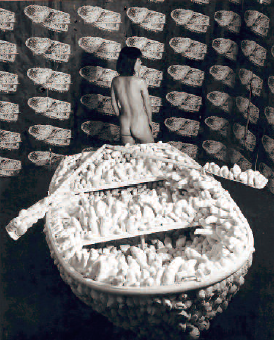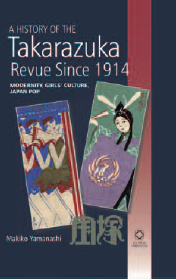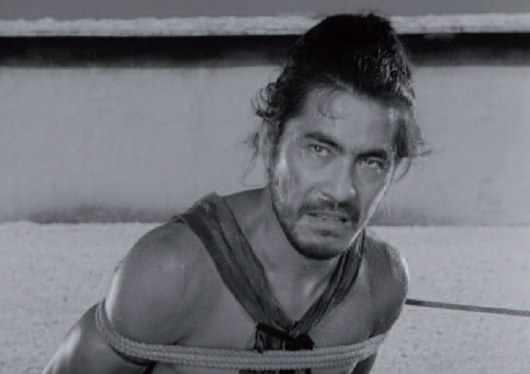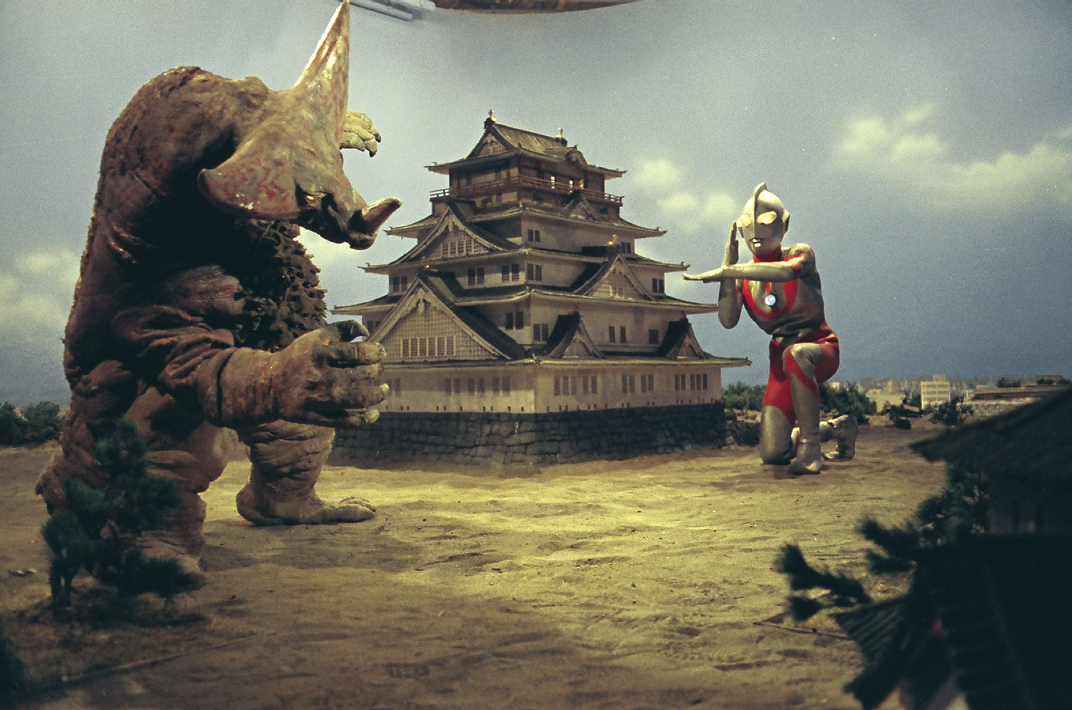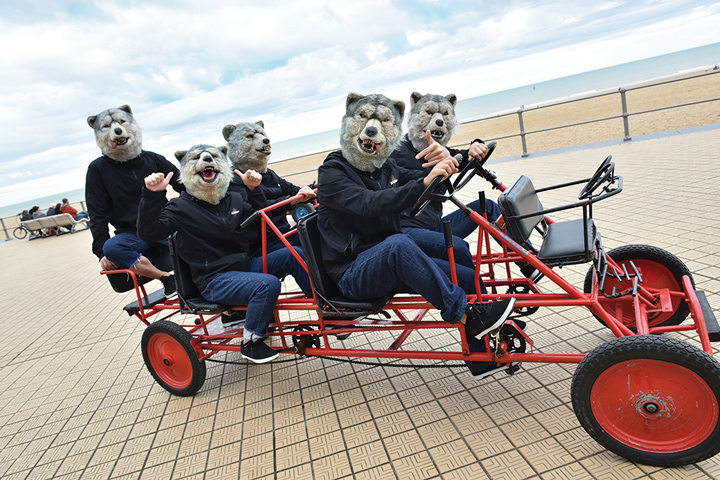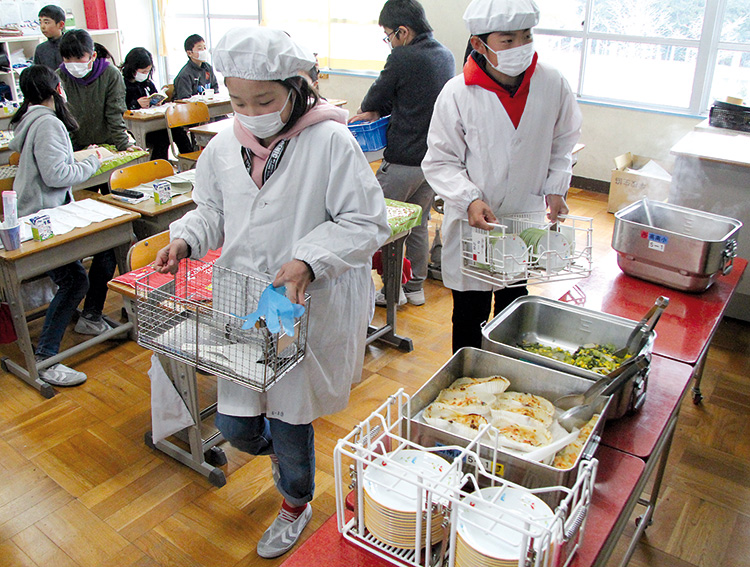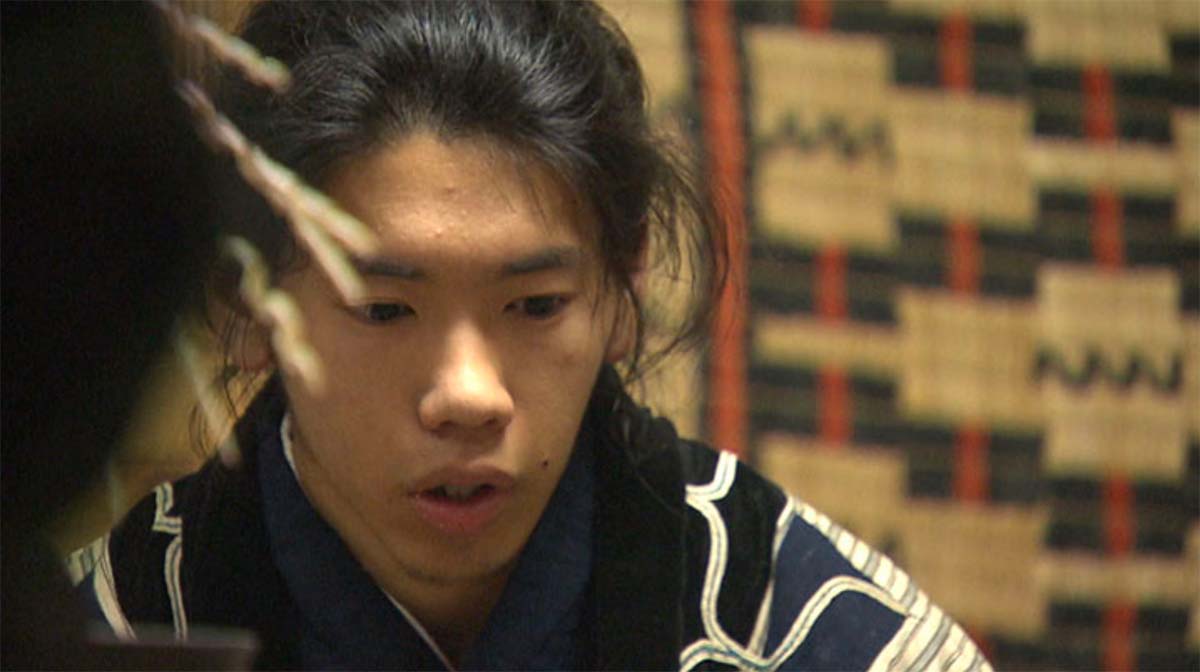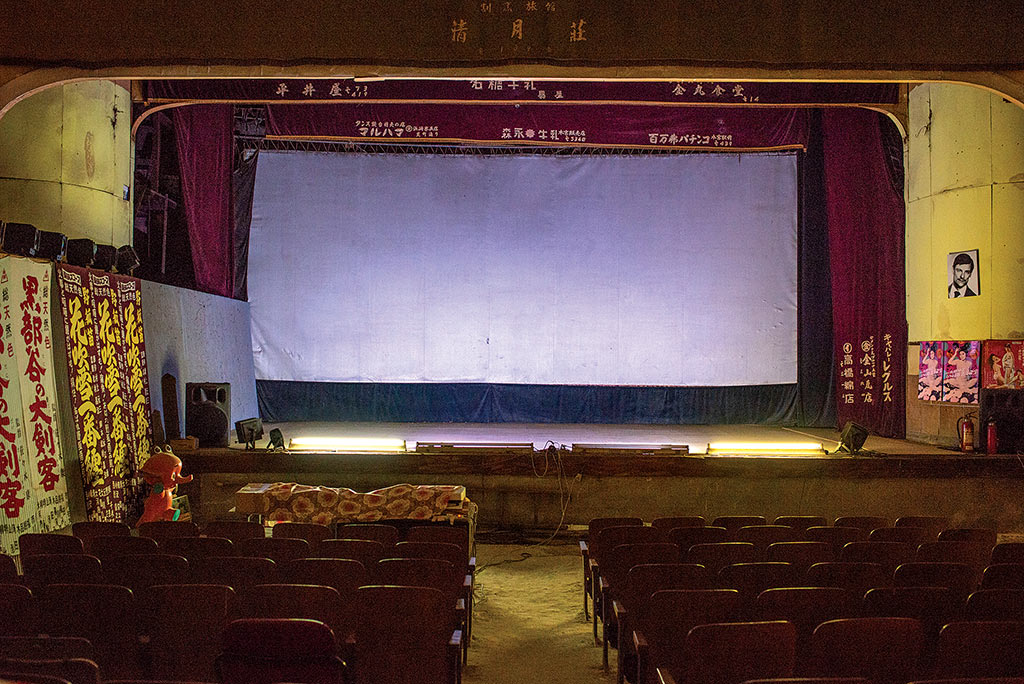

Even though it shows signs of age, Motomiya Eiga Gekijo refuses to succumb.
Hidden treasures and forgotten stories can be found in the most unexpected places. Take Motomiya, Fukushima’s smallest city both in terms of population (30,000) and size. Once a busy shukuba (rest stop and messenger station) with many inns, it has long been bypassed by modern transport. Much of the car traffic is now diverted to nearby Koriyama and Nihonmatsu and even the Shinkansen passes through but does not stop in Motomiya. In other words, one would be hardpressed to find a reason to visit this place.
Yet, if you venture inside the maze of back alleys of a residential district a three-minute walk from the station, you will find a crumbling three-story wooden building whose pink walls sharply contrast with the more subdued colours of the surrounding houses. The bright blue vertical sign that takes up the two upper floors reads “Motomiya Eiga Gekijo” (Motomiya Movie Theatre). Another sign near the entrance proclaims that the cinema was used as a shooting location in Hamelin, a 2013 film by Tsubokawa Takushi, while Roma no kyujitsu (Roman Holidays) is written everywhere (maybe the owner’s favourite film?). But the most striking signboard of all claims that this building is 109 years old.
This being Japan – a country where finding a building that is even just half a century old is cause for wild celebration – this is no mean feat. Moreover, though this movie theatre is in less than pristine condition, it has survived earthquakes, urban redevelopment and wartime raids when Allied bombers targeted the local Gunze factory, which manufactured cloth used to cover the wings of Mitsubishi Zero fighters.
The first version of this cinema, the Motomiyaza( Motomiya Theatre), was built in 1914 – the same year as Tokyo Station – by a volunteer group of 33 prominent local merchants and entrepreneurs led by Komatsu Motoji, a large landowner and politician who served as the prefectural assembly chairman, town mayor and member of the House of Representatives.
Affectionately known by the locals as Jobudai (a name derived from the Fukushima dialect), the three-storey wooden structure could accommodate 800 people and was used for many purposes. Built in the elegant Kabukiza-style, which was cutting-edge at the time, it was a playhouse before the war that showed silent movies, and hosted performances of rokyoku, a genre of traditional narrative singing, generally accompanied by a shamisen (three-stringed instrument), which was very popular in Japan during the first half of the 20th century. In addition, it was used as a public hall for election speeches, gatherings, award ceremonies and even as a professional wrestling venue. Hence, it quickly became the area’s most popular entertainment venue.
In 1943, Tamura Torakichi bought the building and renamed it the Motomiya Eiga Gekijo. Even after the war, it continued to welcome traditional popular theatre troupes, including one led by the famous actor Umezawa Tomio’s father. However, people were increasingly hungry for movies, and screenings began in earnest in 1945 when Tamura installed a new projector. The 1950s were the golden age of Japanese cinema, and the theatre was doing good business even though most new films reached Motomiya only after being shown in bigger cities. It meant that the local audiences had to wait about six months. After the first screening in Fukushima’s main city, the Motomiya Eiga Gekijo was the 50th theatre to get a copy – the second to last in the prefecture.
In 1943, Tamura Torakichi bought the building and renamed it the Motomiya Eiga Gekijo. Even after the war, it continued to welcome traditional popular theatre troupes, including one led by the famous actor Umezawa Tomio’s father. However, people were increasingly hungry for movies, and screenings began in earnest in 1945 when Tamura installed a new projector. The 1950s were the golden age of Japanese cinema, and the theatre was doing good business even though most new films reached Motomiya only after being shown in bigger cities. It meant that the local audiences had to wait about six months. After the first screening in Fukushima’s main city, the Motomiya Eiga Gekijo was the 50th theatre to get a copy – the second to last in the prefecture.
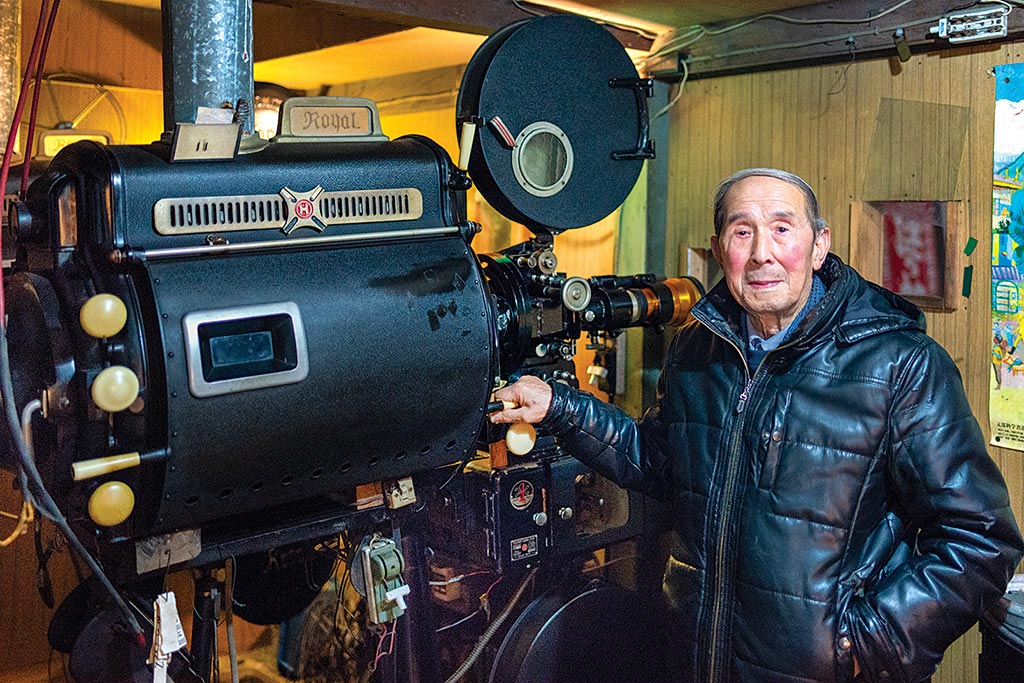
Then, in 1954, Tamura died suddenly and his son Shuji took over. He expanded the theatre’s programming and screened both famous foreign works (e.g. Breathless and Purple Noon) and popular mysteries. The 1950s thus became the theatre’s most successful period. When, in 1955, several places in Motomiya – including the police station – were used as locations in Hisamatsu Seiji’s “Police Diary”, Shuji grabbed the chance to celebrate the big event by screening the film at the same time as it was released in Tokyo. “The film became the city’s biggest hit,” says Shuji who is now 86 years old, “resulting in record-breaking box office takings of 300,000 yen* in three days at a time when the monthly wage was 10,000 yen*. The theatre only had 800 seats but, on that occasion, we managed to cram in 1,000 people over the three floors.”
Unfortunately, the boom years did not last long and in the early 1960s the number of spectators dropped sharply due to the spread of television and other factors. In a last-ditch attempt to attract people and save the business, Shuji went so far as to screen the first pink movies (soft porn) that were then invading the market, but this move was not well received. In the meantime, debts were piling up and Shuji was forced to close down the theatre. The Motomiya Eiga Gekijo screened its last show in August 1963.
Shuji became a car salesman and managed to pay off his debts in around three years. By the time he retired at the age of 65, cinema complexes had become mainstream, digitalisation was progressing, and reopening his beloved theatre was not realistic. Nevertheless, Shuji had a dream: “I just couldn’t give up,” he says, “I wanted to welcome audiences and show them films again after I retired.” To that end, and in opposition to his family, he continued to look after the films he still had as well as his precious projector, regularly oiling its parts and keeping it in working condition. He had done his best to prevent the old building from falling to pieces, cleaning the hall and waiting for the day when the big white screen would come to life again.
However, Shuji had to face the harsh reality. “Like Urashima Taro [the protagonist of a famous fairy tale], there were only old people around me,” he says. “I thought it would be impossible to revive the theatre.”
Then, in 2008, the unexpected happened. “At the time, I was going to an ophthalmology clinic in Motomiya to get eye treatment,” Shuji says. “The doctor, who is about my age, expressed a desire to watch a movie at my theatre, and I just could not say no. I wanted to express my gratitude to him and the nurses for how well they had taken care of me.” And suddenly, the crumbling building, which was thought to be ruined forever, opened again for a private screening. Some 150 people gathered in front of the screen and a film was shown to an audience for the first time in 45 years. But that was not all: the event was reported in the newspapers, it became a hot topic, and visitors from all over the country came to visit this ancient survivor from the golden age of cinema.
Exactly as Shuji had imagined for all those years, the Motomiya Eiga Gekijo was given a second chance. More screenings followed and, in 2014, a special event was held to commemorate the 100th anniversary of its opening. However, it was not all smooth sailing: in March 2011, the second and third floors were severely damaged by the Great East Japan Earthquake. Then, in October 2019, the East Japan Typhoon caused a flood. “I noticed the flooding around midnight while I was sleeping at home,” Shuji says. “Luckily, since the theatre is on high ground, the water only came up to just below my knees.” Miraculously, the screen and, most importantly, the projector emerged unscathed both times. However, the front seats were flooded. “I had to scrape out the mud that had accumulated in the theatre with the help of an acquaintance,” Shuji says.
When news of the damage spread via social media, support poured in from all over the country, and restoration work was carried out until the following spring when a comeback screening was planned, but the event fell through due to the Covid-19 crisis.
A visit to the Motomiya Eiga Gekijo truly feels like taking a time machine back to the Showa period (1926-1989) when cinema- going was both a common and magical experience. In the dimly lit lobby, next to cuttings of interviews and articles about the theatre and its owner, there are photos of stars of the silver screen such as Kitaoji Kin’ya and Kobayashi Akira as well as posters of Showa-era movies. It is here that Shuji spends many days during the warmer months, sitting on a chair near the entrance.
The retro feeling and nostalgic atmosphere even pervade the parterre. The exposed concrete floor looks rough, but the 100 wooden chairs are surprisingly comfortable to sit on and the zabuton (traditional cushions) add a nice homely touch. These are the only seats available: after the two upper floors were damaged by the earthquake, the gallery area was walled up and is now closed off to the public.
In a sense, the most surprising place inside the theatre is the projection room. It is here that a real relic can be admired: a carbon-type projector made in 1957. Shuji says that this is the only place in the prefecture where a projector of this type can be found, but it would probably be hard to find a similar model anywhere in Japan. Most people have no idea how it works anymore, so Shuji patiently explains how he conjures up moving images from this ancient machine.
“Instead of a xenon arc lamp, which is the most common light source today, this projector uses carbon rods as electrodes,” he says. “To be more precise, there are two types of carbon rods: “positive rods” and “negative rods”. When the positive and negative are brought close together, electricity flows and the projector uses the light emitted. As the rods burn, they shorten little by little like a candle.
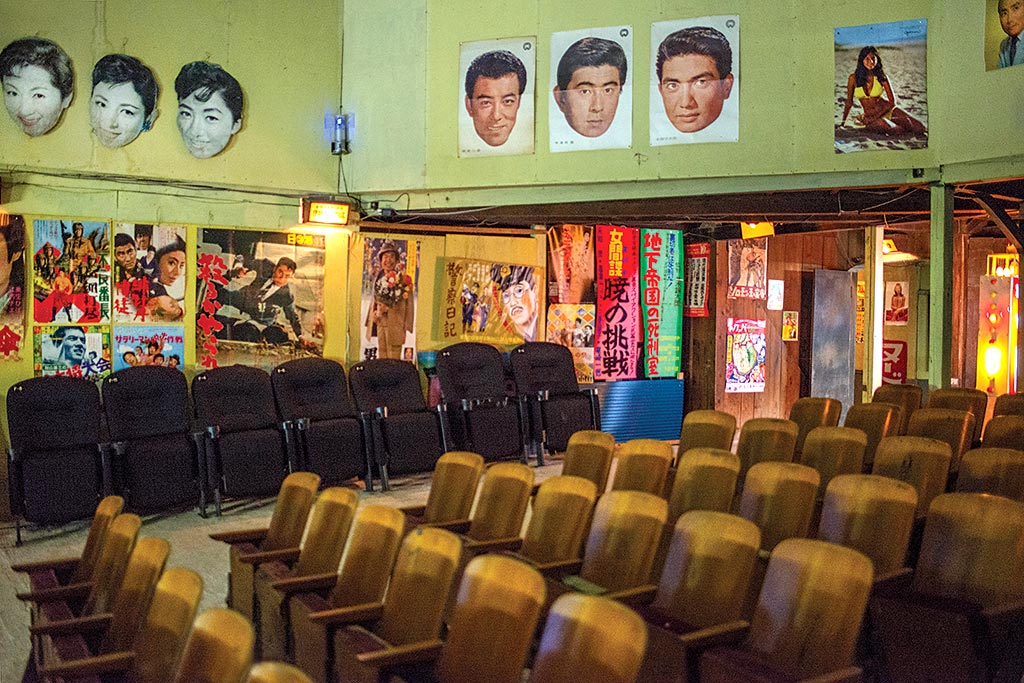
“However, there is a drawback to this system: we constantly have to make sure that the right distance between the rods is maintained. In other words, they can be neither too close together nor too far apart. It is the job of the projectionist to finely adjust the distance between them.”
According to Shuji, another problem with this kind of machine is that since the electrodes are not enclosed in a glass bulb like a xenon lamp, the projector generates a lot of heat, so during the screening the area around the projector becomes very hot. “It gets pretty hot in the projection room, and it is a sweaty job in the summer,” he says, “but the projectionist must be careful that it does not catch fire. This was particularly dangerous in the past, with old films that used flammable celluloid film.”
In 1984, a fire broke out at the National Film Centre of the National Museum of Modern Art in Tokyo, destroying many valuable films shot on celluloid film which had been stored there. Luckily, the industry transitioned to cellulose acetate film (also called “safety film”) in the mid- 1950s, and later to polyester film stock, while now many theatres use digital projectors. “People come from all around Japan to experience a film shown on an old projector,” Shuji says. “It may not be as beautiful as digital, but the warm feeling you get from it is rather unique.”
Currently, the Motomiya Eiga Gekijo is managed jointly by Shuji and his daughter Yuko who usually lives in Tokyo and works at a “mini theatre” (a small independent cinema). Screenings are held several times a year, including hosting group trips. The theatre is also used as an event and concert venue as well as a filming location. “People often visit, even when the theatre is closed, just to have a look,” Shuji says. “I am happy that they want to see a place that has been empty for such a long time. After all, movies are my purpose in life. But I never thought I would be in the limelight at my age,” he laughs. The Tamuras often screen compilations made by Shuji by choosing and editing the best scenes from the films he has on hand. “I want to create interesting shows that will please the audience by leaving out the boring bits,” he says. “It is like the last scene in Cinema Paradiso. I want to show movies that will remain in people’s memories.
“Also, in November 2021, we organised a programme to tour around the old movie theatres (e.g. Asahiza, Shintomiza) that still survive in Fukushima,” Yuko says, “and we had an opportunity to show Police Diary again, the film that still holds Motomiya’s box office record 66 years after its original screening. It was a memorable event for us.”
Though the theatre is only open for a few days every year, Shuji is careful to carry out maintenance as often as possible so that they can screen movies at any time. “Preparation time is the same for a two-minute or a two-hour film,” he says. “You see, it is not impossible to show the movie right away, but I have to check the film, check the condition of the projector, clean the venue… I want to be polite to the customers. If those things are neglected, it is easy for the film to be ruined or for accidents to occur.”
All over Japan, old movie theatres are closing one after another, and it is very difficult for a cinema to fill a whole building as they did in the past. Most theatres are now located within large-scale commercial complexes as tenants. “A lot of people seem to agree that it is nearly impossible to make a living in this business,” Yuko says, “yet new movies continue to be made. I even get phone calls from filmmakers asking me to screen their own work. Other people visit while scouting for locations and when they step into the theatre, you can see how excited they get. And, some time ago, a local man in his 60s brought the DVD of a monster movie that he had missed when it had been released and watched it on the big screen. Rental movie theatres… is that not a great idea?”
The 2019 typhoon, flood damage and the Covid- 19 pandemic have scarred the region and people have moved away. Familiar family-run shops and sweet shops have disappeared. This is the sad reality. But the Tamuras are not done yet. “The Motomiya Eiga Gekijo is still alive and well because people keep coming,” Shuji says, “and I will keep running and protecting this theatre for as long as movies are made.”
Gianni Simone

